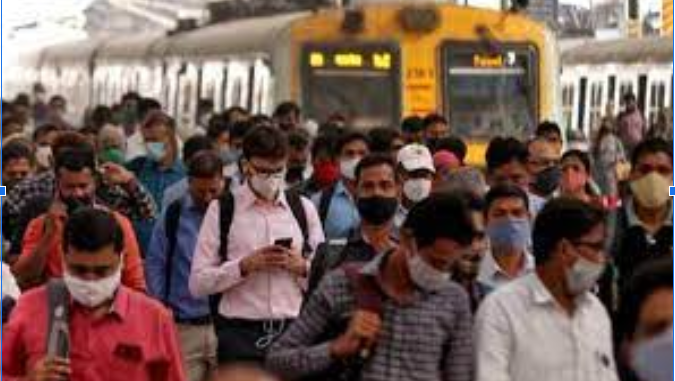
Tracking Mumbai’s three Covid-19 waves: SARS-CoV-2, the coronavirus that causes Covid-19 disease, can be detected in upper respiratory tract for up to three months of the onset of illness.
MUMBAI: Soon after the Covid-19 pandemic started in March 2020, patients occupied hospital beds right up until their Reverse Transcription Polymerase Chain Reaction (RT-PCR) tests to detect the coronavirus were negative, which often took several days. Two years later, as we face a third wave of cases in Mumbai, the treatment protocol has changed. Today, a repeat RT-PCR is strictly disallowed, except when symptoms worsen. To track the pandemic is to understand how our treatment and hospitalisation protocols have transformed over the past two years. Doctors now know that SARS-CoV-2, the coronavirus that causes Covid-19 disease, can be detected in upper respiratory tract for up to three months of the onset of illness. However, the virus after a five to 10-day time period is not “replication competent” if the symptoms have subsided, which means that it is not likely to be infectious.
Protocols changed
In the third wave some therapies remain significant, while others have disappeared from the protocol followed by treating physicians. There is still a lot to learn, doctors said.
The earliest guidelines for clinical management of Covid-19 was issued by ministry of Health and Family Welfare in March 2020. Members of the Covid-19 task force in each state also developed treatment guidelines, based on evidence from the West, clinical practice and the Centre’s suggestions. The Indian Council of Medical Research ICMR) national Covid-19 task force has since then issued clinical guidance. “Three therapies — oxygen, steroids and anticoagulants — have stood the test of time and have made a difference when it comes to saving lives,” said infectious disease expert Dr Tanu Singhal, Kokilaben Dhirubhai Ambani Hospital. Singhal said that many drugs were re-purposed for Covid-19. For instance, in the first wave, doctors commonly used the antibiotic, azithromycin and anti-malarial drug, hydroxychloroquine which is also often used to treat rheumatoid arthritis. Drugs like antibiotic doxycycline and anti-parasitic ivermectin became a part of the unspecified treatment protocol. “All these drugs have gone away from the current line of treatment,” Singhal said. Two medicines — antiviral remdesivir and an anti-inflammatory drug tocilizumab — used in the first wave, stayed on. “We have conflicting data over the past two years on these two drugs, but they are useful when administered at the right time,” she said. A study published in the New England Journal of Medicine (NEJM) in December 2021 showed that early Remdesivir could prevent progression to severe disease if the drug was given on an outpatient basis. Till now, the common remdesivir course has been for five days and it has been administered only to hospitalised patients. This drug was also in short supply in the second wave of the pandemic, leading the Bombay high court to order the state to procure more vials as well as monitor its sale. Some of the treatments used in the first wave were downright wrong. For instance, the use of convalescent plasma, a blood component taken from recovered patients— there was insufficient evidence to show that it worked. By the second wave, the medical fraternity was slightly more confident in dealing with patients. But the enormity of the wave, driven by the Delta variant, overwhelmed the healthcare system. “We began intubating patients much earlier in the second wave in order to reduce mortality,” said internal medicine specialist Dr Anita Mathew from Fortis Hospital. “Early oxygen therapy also played a key role in recovery,” she said. “Continuous overuse of antibiotics to deal with a virus, high doses and unwarranted use of steroids and unnecessary CT scans were some of the biggest errors we saw. We risked antibiotic resistance, allowed the spread of life-threatening fungal infections such as mucormycosis and further caused the spread of infection as crowds gathered at radiology centres. It felt like there was a lack of common sense,” Dr Sujeet K Rajan, a respiratory medicine specialist from Bombay Hospital, said. Third wave, new treatments in India granted an Emergency Use Authorisation (EUA) to the monoclonal antibody cocktail drug in May 2021, but by the time it came into use, the second wave had started receding. The cocktail drug gained prominence in the third wave, but data has now shown that the two monoclonal antibodies — casirivimab and imdevimab — available in India failed to neutralise the Omicron variant in a laboratory setting, according to a study published by Frankfurt-based researchers in December 2021. “Timing is everything when it comes to Covid-19,” said critical care specialist Dr Kedar Toraskar from Wockhardt Hospital, who is also a member of Maharashtra’s Covid-19 task force. “We now know that antivirals like remdesivir, and even the new drug molnupiravir works best during the viremia phase [presence of the virus in the bloodstream]. It goes without saying that doctors should select the patients carefully considering all the contraindications. Steroids, anticoagulants, and immunomodulator drugs are to be used in the inflammatory and cytokine storm phases,” said Toraskar. Experts also said that a lot has also changed because the virus is up against a population that has vaccine-induced immunity and past infection-induced immunity. “Proper use of masks and vaccinations will continue to be the key,” said Dr Mathew of Fortis.






